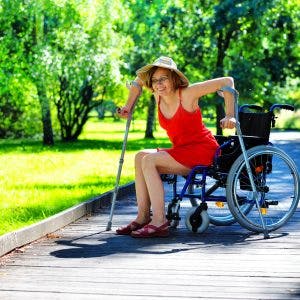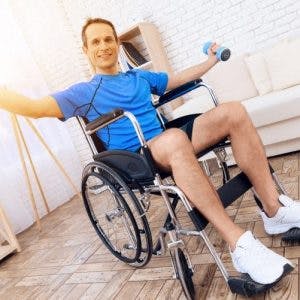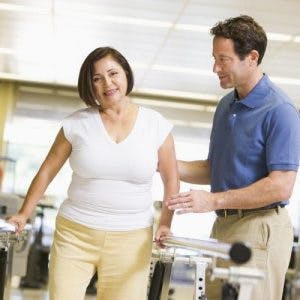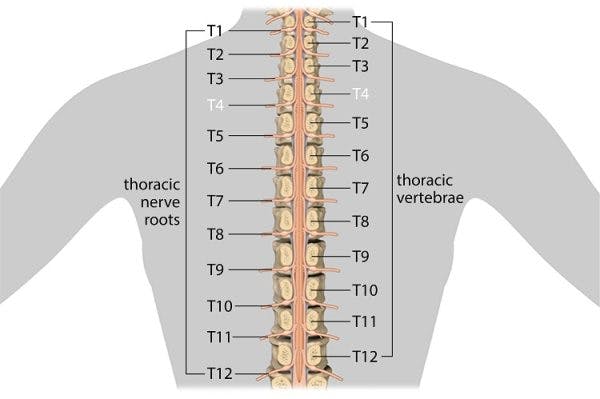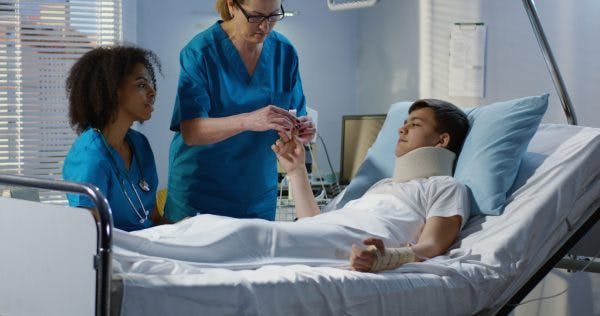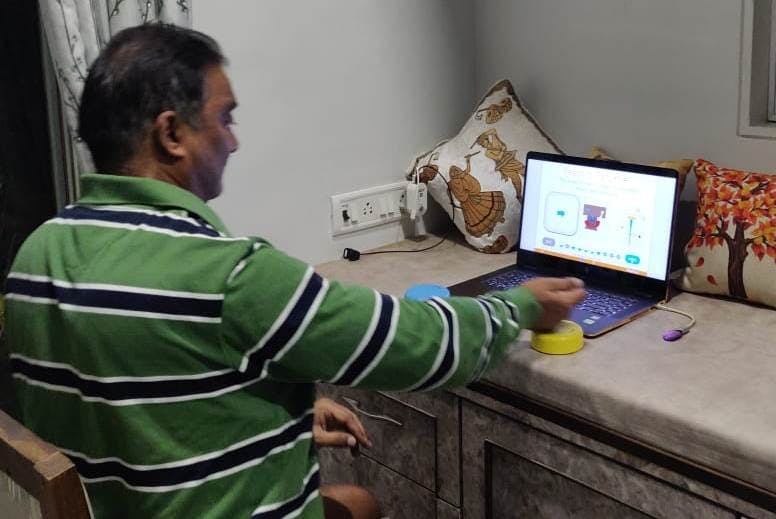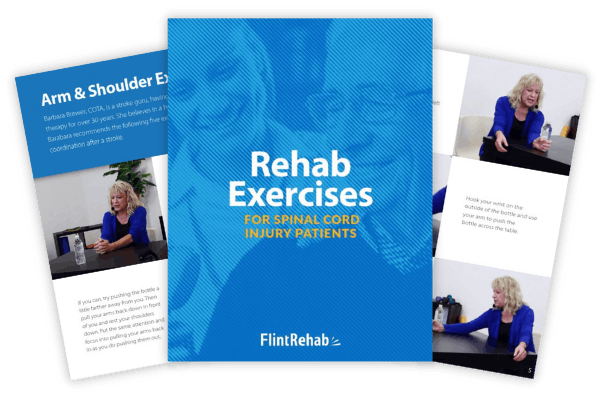A C4 spinal cord injury is a type of cervical spinal cord injury that occurs when this specific segment of the spinal cord is damaged. Damage to the spinal cord can affect motor and sensation below the level of injury, therefore making cervical spinal cord injuries the most severe type, sometimes resulting in paralysis from the neck down (quadriplegia).
C4 spinal cord injuries make up about 15.3% of all spinal cord injuries, making them the most common level of injury. However, even amongst C4 spinal cord injury patients, functional outcomes, complications, and recovery outlook widely vary.
This article will go over what to expect after a C4 spinal cord injury and how to promote recovery.
Complete vs. Incomplete C4 Spinal Cord Injury
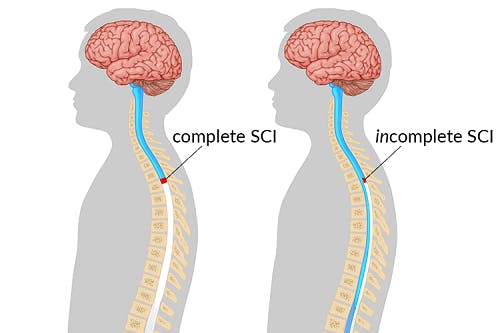
The severity of a spinal cord injury significantly affects one’s functional outcomes and recovery outlook. One important factor that indicates the severity of an SCI is whether the injury is complete or incomplete.
A complete spinal cord injury refers to damage that cuts all the way across the spinal cord, leaving no spared neural connections. This means that there are no pathways connecting areas below your level of injury to the brain.
As a result, individuals with complete C4 spinal cord injuries cannot control movements or feel sensations below the C4 level of injury.
In contrast, an incomplete spinal cord injury refers to partial spinal cord damage. Some connections between the brain and areas below the level of injury will exist and as a result, individuals may be able to move or feel areas below the C4 level of injury.
As long as some neural pathways between the brain and areas below the level of injury exist, a spinal cord injury is incomplete. Spared neural pathways are essential for recovery after a spinal cord injury because they’re capable of neuroplasticity.
Neuroplasticity is the central nervous system’s ability to adapt and rewire itself so that functions weakened by SCI can be relearned. The less severe a spinal cord injury is, the more spared neural pathways exist, and the better the recovery outlook.
Want 15 pages of SCI recovery exercises in PDF form? Click here to download our free SCI Rehab Exercise ebook now (link opens a pop up for uninterrupted reading)
Up next, we’ll discuss which functions can be affected by C4 spinal cord injury.
Functions Affected by C4 Spinal Cord Injury
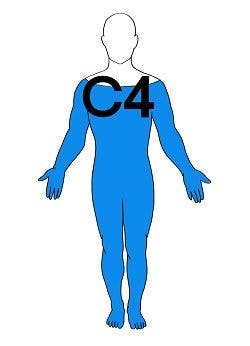
The spinal cord is split into 31 segments and each segment connects to, or innervates, a different area of skin for sensation and muscles for movement.
Level of injury refers to the bottommost segment of the spinal cord where normal motor and sensory functions exist.
The C4 nerve roots affect sensation at the shoulders, upper back, and upper chest. They also affect control over the muscles that allow you to raise your shoulders. As a result, individuals with C4 spinal cord injuries generally have normal sensation and motor control in their heads and neck, and are typically able to shrug their shoulders.
Additionally, the C3-C5 nerve roots innervate the diaphragm, so individuals with a C4 spinal cord injury may experience weakened respiratory functions.
Because messages between the brain and areas below the level of injury cannot pass through the spinal cord damage, all functions innervated below the level of injury can be affected. The photo above demonstrates which functions can be affected following a C4 spinal cord injury. As previously mentioned, this will all depend on the severity of your injury.
In the following section, we’ll discuss complications that can occur after a C4 SCI.
Potential Complications of C4 Spinal Cord Injury

Depending on the severity of one’s C4 spinal cord injury, the complications can vary. Generally, those with more severe SCIs are more likely to experience complications due to greater immobility.
Below, we’ll go over 7 common complications amongst C4 SCI patients.
Bladder and Bowel Dysfunction
After a C4 spinal cord injury, individuals may lose sensation and control over the bowel and bladder muscles. Because the bowel and bladder muscles are innervated by some of the bottommost segments of the spinal cord, bladder and bowel dysfunction is extremely common amongst SCI patients.
Individuals may not be able to feel when their bladders or bowels are full, and they may have difficulty releasing the muscles necessary to remove waste. Both of these factors increase their risk of leaking, urinary retention, constipation, and kidney damage.
Sexual Dysfunction
Many sexual functions are under reflexive control of the spinal cord or controlled by regions of the brain such as the limbic system and hypothalamus. A C4 spinal cord injury can disrupt the transmission of messages between the brain, spinal cord, and sexual organs, resulting in sexual dysfunction.
Breathing Difficulties
Because the C3-C5 nerve roots innervate the diaphragm, C4 SCI patients may experience breathing difficulties and need ventilator assistance. Additionally, individuals may not be able to produce a strong enough cough to clear mucus buildup in the lungs, which increases their risk of respiratory complications. Through breathing and coughing exercises, many SCI patients are able to wean off ventilator dependence.
Changes in Body Composition
When physical activity is drastically reduced due to paralysis or severe weakness, significant changes in body composition can occur. A sedentary lifestyle can result in poor circulation, slowed metabolic rate, reduced bone density, and muscle atrophy.
Pressure Sores
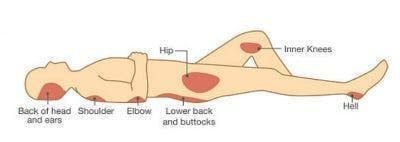
Reduced mobility and lack of sensation can increase one’s risk of developing pressure sores. Pressure sores occur when too much pressure is placed on a specific area for extended periods. They most commonly form over bony areas such as the ankles, elbows, knees, tailbone, and hips.
Autonomic Dysreflexia
Autonomic dysreflexia is characterized by a spike in blood pressure due to noxious stimulation below the level of injury. The most common causes of autonomic dysreflexia are a full bladder, distended bowels/constipation, tight clothes, skin irritations, and extreme temperatures.
Other symptoms of autonomic dysreflexia include headache, hypertension, sweating, and shortness of breath.
Spasticity
Spasticity describes involuntary muscle contractions below one’s level of injury. The muscles remain contracted because they’re not receiving signals from the brain to relax.
Individuals with spasticity may experience stiff movements or jerky spasms. If not properly managed, spasticity can excessively strain the musculoskeletal system and cause chronic pain.
Now that you understand the various complications that can arise following a C4 spinal cord injury, let’s discuss management techniques.
C4 Spinal Cord Injury Recovery

Because the outcomes of every C4 spinal cord injury are different, a personalized approach to rehabilitation is essential.
Below, we’ll discuss rehabilitation interventions that can help you cope, improve your mobility, and manage secondary complications.
- Physical therapy can help SCI patients improve their mobility through exercise. A physical therapist will assess one’s functional abilities, create a personalized exercise regimen, and help patients work towards realistic recovery goals.
- Occupational therapy will help C4 spinal cord injury patients learn how to maximize their mobility by practicing activities of daily living. This can involve learning how to use adaptive tools and practicing new techniques to compensate for lost functions.
- Psychotherapy can help individuals better cope with mental distress, depression, anxiety, or post-traumatic stress following an SCI.
- Joining a support group can help you connect with other individuals with spinal cord injuries and share experiences. This can be a great source of comfort and information.
- Hiring a caregiver can help those with severe paralysis complete daily activities like eating, grooming, and toileting.
- Orthotic devices like braces or splints help promote musculoskeletal alignment. For example, individuals with severe paralysis after a C4 SCI may struggle to sit upright and may need to wear a trunk brace for extra support. Similarly, individuals with stiff limbs may benefit from wearing a brace that can help prevent further contractions and mildly stretch spastic muscles.
- Breathing and coughing exercises can help strengthen your respiratory muscles. Additionally, individuals should make an effort to drink lots of water to help thin out mucus buildup and make it easier to clear the lungs. Speech therapy may be necessary if you are ventilator dependent and/or have trouble managing respiratory secretions.
- Medications can provide relief for a variety of SCI complications. For example, individuals with bowel and bladder dysfunction may need to take laxatives or suppositories. In contrast, individuals with spasticity may need to take muscle relaxants and those with neuropathic pain may need to take pain relievers.
- Surgery can help reduce severe spasticity. It typically involves manual lengthening of tight muscles and tendons or making selective nerve incisions to denervate overactive muscles.
C4 Spinal Cord Injury: Key Points
A C4 spinal cord injury can affect sensation and motor control from the shoulders down. However, depending on the severity of the SCI, some functions below the level of injury may not be affected.
Every spinal cord injury is unique and the onset of complications will vary. Rehabilitative therapies and effective management interventions can help reduce complications and improve your quality of life. We hope this article helped you understand what to expect after a C4 spinal cord injury.





